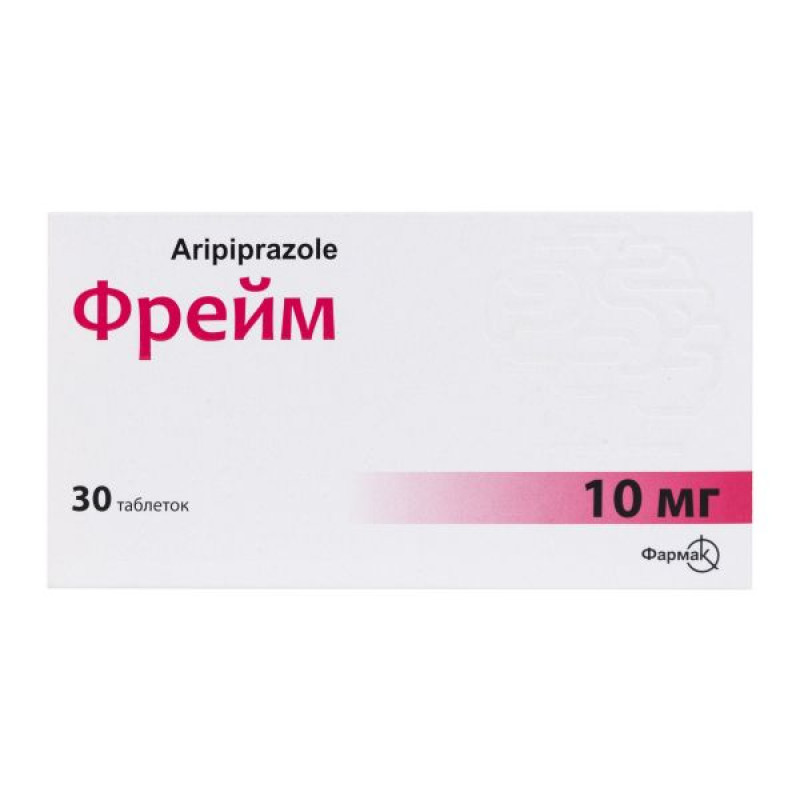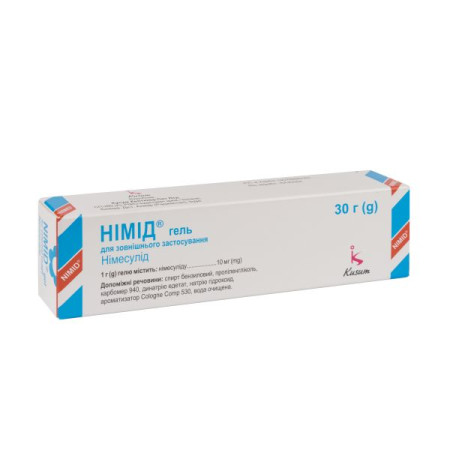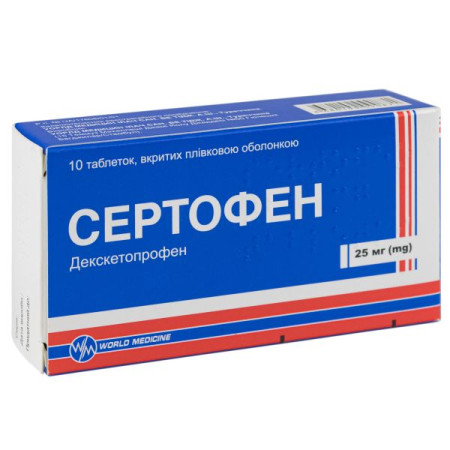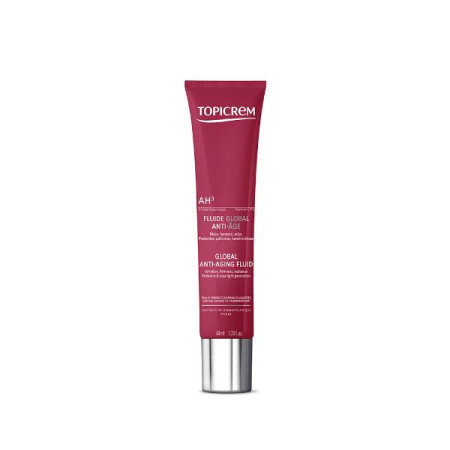Frame tablets 10 mg blister No. 30
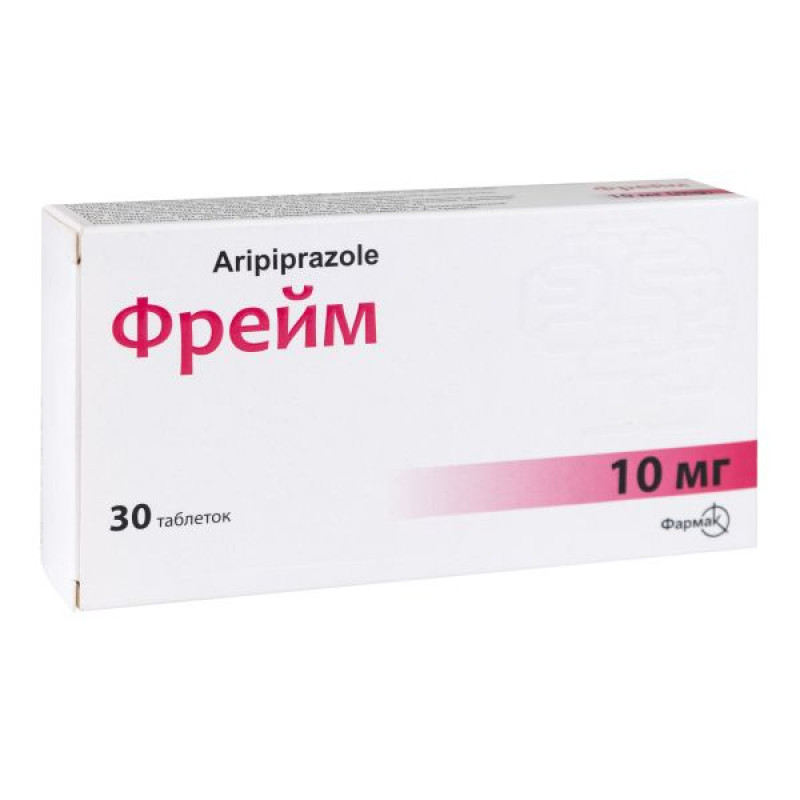
Instructions Frame tablets 10 mg blister No. 30
Composition
active ingredient: aripiprazole;
1 tablet contains 5 mg or 10 mg, or 15 mg, or 30 mg of aripiprazole;
excipients:
5 mg tablets: lactose monohydrate; microcrystalline cellulose; croscarmellose sodium; colloidal anhydrous silica; magnesium stearate; indigo carmine (E 132); vanilla flavouring (contains propylene glycol and benzyl alcohol); aspartame (E 951);
10 mg tablets: lactose monohydrate; microcrystalline cellulose; croscarmellose sodium; colloidal anhydrous silica; magnesium stearate; red iron oxide (E 172); vanilla flavour (contains propylene glycol and benzyl alcohol); aspartame (E 951);
15 mg tablets: lactose monohydrate; microcrystalline cellulose; croscarmellose sodium; colloidal anhydrous silica; magnesium stearate; yellow iron oxide (E 172); vanilla flavouring (contains propylene glycol and benzyl alcohol); aspartame (E 951);
30 mg tablets: lactose monohydrate; microcrystalline cellulose; croscarmellose sodium; colloidal anhydrous silica; magnesium stearate; red iron oxide (E 172); vanilla flavour (contains propylene glycol and benzyl alcohol); aspartame (E 951).
Dosage form
Pills.
Main physicochemical properties:
5 mg tablets - blue, rectangular, biconvex tablets, smooth on both sides;
10 mg tablets - pink, rectangular, biconvex tablets, smooth on both sides;
15 mg tablets - yellow, round, flat tablets, smooth on both sides;
30 mg tablets are pink, round, flat tablets, smooth on both sides.
Pharmacotherapeutic group
Antipsychotics (neuroleptics).
ATX code N05A X12.
Pharmacological properties
Pharmacodynamics.
Mechanism of action
The therapeutic effect of aripiprazole in schizophrenia and bipolar I disorder is due to a combination of partial agonist activity at D2-dopamine and 5HT1a-serotonin receptors and antagonist activity at 5HT2-serotonin receptors.
Aripiprazole has high affinity in vitro for D2 and D3 dopamine receptors, 5HT1a and 5HT2a serotonin receptors and moderate affinity for D4 dopamine, 5HT2c and 5HT7 serotonin receptors, α1-adrenoceptors and H1-histamine receptors. Aripiprazole also has moderate affinity for serotonin reuptake sites and no affinity for muscarinic receptors. Aripiprazole has been shown to antagonize dopaminergic hyperactivity and agonize dopaminergic hypoactivity in animal experiments. Interactions beyond dopamine and serotonin receptors may explain some of the clinical effects of aripiprazole.
Clinical efficacy and safety
Adults
Schizophrenia
In three short-term (4 to 6 weeks) placebo-controlled studies in 1228 adult patients with schizophrenia who had positive or negative symptoms, aripiprazole was associated with statistically significant improvements in psychotic symptoms compared to placebo.
Aripiprazole is effective in maintaining clinical improvement with continued therapy in adult patients who have shown an initial response to treatment. In a haloperidol-controlled study, the proportion of patients who responded to the drug at 52 weeks was similar in both groups (aripiprazole 77% and haloperidol 73%). Overall, the final percentage was significantly higher for patients treated with aripiprazole (43%) than for patients treated with haloperidol (30%).
Actual scores on scales used as secondary endpoints, including the PANSS and the Montgomery-Osberg Depression Rating Scale (MADRS), showed significant improvement with aripiprazole compared with haloperidol.
In a 26-week placebo-controlled study in adult, stable patients with chronic schizophrenia, aripiprazole significantly reduced relapse rates: 34% in the aripiprazole group and 57% in the placebo group.
Weight gain
Aripiprazole has not been shown to cause clinically significant weight gain in clinical trials. In a 26-week, double-blind, multinational, olanzapine-controlled study of schizophrenia in 314 adult patients, where the primary endpoint was weight gain, significantly fewer patients had at least 7% weight gain from baseline (i.e., an increase of at least 5.6 kg from a mean baseline weight of 80.5 kg) with aripiprazole (n = 18, or 13% of evaluable patients) compared with olanzapine (n = 45, or 33% of evaluable patients).
Lipid parameters
In a pooled analysis of lipid parameters from placebo-controlled clinical trials in adults, aripiprazole was not shown to cause clinically meaningful changes in total cholesterol, triglycerides, high-density lipoprotein (HDL), and low-density lipoprotein (LDL) levels.
Prolactin
The incidence of hypoprolactinemia, or decreased serum prolactin levels, was 0.4% in patients treated with aripiprazole compared with 0.02% in patients treated with placebo. In patients treated with aripiprazole, the median time to onset of these changes was 30 days and the median duration was 194 days.
Manic episodes in bipolar I disorder
In two 3-week, placebo-controlled, flexible-dose monotherapy studies in patients with a manic or mixed episode of bipolar I disorder, aripiprazole demonstrated superior efficacy compared to placebo in reducing manic symptoms over 3 weeks. These studies included patients with or without psychotic features, with or without rapid cycling.
In one 3-week, placebo-controlled, fixed-dose monotherapy study in patients with a manic or mixed episode of bipolar I disorder, aripiprazole did not demonstrate superior efficacy compared to placebo.
In two 12-week placebo- and active-controlled monotherapy studies in patients with a manic or mixed episode of bipolar I disorder, with or without psychotic features, aripiprazole demonstrated superior efficacy to placebo at week 3 and maintenance of efficacy comparable to lithium or haloperidol at week 12. The proportion of patients with symptomatic remission of mania with aripiprazole at week 12 was also comparable to that with lithium or haloperidol.
In a 6-week placebo-controlled study in patients with a manic or mixed episode of bipolar I disorder with or without psychotic features who had partially failed to respond to lithium or valproate monotherapy for 2 weeks at therapeutic serum levels, aripiprazole as add-on therapy was superior to lithium or valproate monotherapy in reducing manic symptoms.
In a 26-week placebo-controlled study with a subsequent 74-week extension in manic patients who achieved remission on aripiprazole during the stabilization phase prior to randomization, aripiprazole demonstrated superiority over placebo in preventing relapse in bipolar disorder, primarily in preventing relapse into mania, but failed to demonstrate superiority over placebo in preventing relapse into depression.
In a 52-week placebo-controlled trial in patients with a current manic or mixed episode of bipolar I disorder who achieved sustained remission (Young Mania Rating Scale [YMRS] and MADRS total scores ≤ 12) on aripiprazole (10-30 mg/day), add-on aripiprazole demonstrated superiority over placebo with a 46% risk reduction (hazard ratio 0.54) in preventing recurrence of bipolar disorder and a 65% risk reduction (hazard ratio 0.35) in preventing recurrence of mania, but did not demonstrate superiority over placebo in preventing recurrence of depression. Add-on aripiprazole demonstrated superiority over placebo on the secondary outcome measures Clinical Global Impression — Bipolar version (CGI-BP) and Severity of Illness (SOI; mania). In this study, patients were assigned to open-label monotherapy with lithium or valproate to determine partial non-response. Patients were stabilized for at least 12 consecutive weeks on a combination of aripiprazole and the same mood stabilizer. Stabilized patients were then randomized to continue the mood stabilizer with double-blind aripiprazole or placebo. Four mood stabilizer subgroups were evaluated in the randomized phase: aripiprazole + lithium; aripiprazole + valproate; placebo + lithium; and placebo + valproate. The Kaplan-Meier rate of recurrence of any mood episode in the adjunctive treatment group was 16% for aripiprazole + lithium and 18% for aripiprazole + valproate, compared with 45% for placebo + lithium and 19% for placebo + valproate.
Children
Schizophrenia in adolescents
In a 60-89 week, randomized, double-blind, placebo-controlled study in adolescents (n = 146; ages 13 to 17 years) with schizophrenia, there was a statistically significant difference in the rate of psychotic symptom recurrence between the aripiprazole (19.39%) and placebo (37.50%) groups. The point estimate of the hazard ratio (HR) was 0.461 (95% confidence interval 0.242 to 0.879) in the overall population. In a subgroup analysis, the point estimate of heart rate (HR) was 0.495 for subjects aged 13 to 14 years compared with 0.454 for subjects aged 15 to 17 years. However, the estimate of heart rate for the younger (13 to 14 years) group was imprecise, reflecting the smaller number of subjects in this group (aripiprazole: n = 29; placebo: n = 12), and the confidence interval for this group (0.151 to 1.628) did not allow conclusions to be drawn about the presence of a treatment effect. In contrast, the 95% confidence interval for heart rate in the older subgroup (aripiprazole: n = 69; placebo: n = 36) was 0.242 to 0.879, and therefore a conclusion about a treatment effect could be drawn in older patients.
Manic episodes in bipolar I disorder in children and adolescents
Aripiprazole was studied in a 30-week, placebo-controlled study in 296 children and adolescents (10 to 17 years of age) who met DSM-IV (Diagnostic and Statistical Manual of Mental Disorders) criteria for bipolar I disorder with manic or mixed episodes with or without psychotic features and had a YMRS score ≥ 20 at baseline. Among patients included in the primary efficacy analysis, 139 patients had a current co-morbid diagnosis of attention deficit hyperactivity disorder (ADHD).
Aripiprazole was superior to placebo in the Y-MRS total score compared to baseline at week 4 and week 12. In a retrospective analysis, the improvement compared to placebo was greater in patients with comorbid ADHD compared to the non-ADHD group, where there was no difference from placebo. Relapse prevention has not been established.
The most common treatment-emergent adverse reactions in patients receiving 30 mg were extrapyramidal disorders (28.3%), somnolence (27.3%), headache (23.2%), and nausea (14.1%). The mean weight gain over the 30-week treatment interval was 2.9 kg compared with 0.98 kg in patients receiving placebo.
Irritability associated with autistic disorder in children
Aripiprazole was studied in patients aged 6 to 17 years in two 8-week placebo-controlled studies [one flexible dose (2-15 mg/day) and one fixed dose (5 mg/day, 10 mg/day, or 15 mg/day)] and one open-label 52-week study. In these studies, dosing was initiated at 2 mg/day, increased to 5 mg/day after one week, and increased by 5 mg/day in weekly increments to the target dose. More than 75% of patients were younger than 13 years. Aripiprazole demonstrated statistically significant superiority over placebo on the irritability subscale of the Aberrant Behavior Checklist. However, the clinical significance of this finding has not been established. The safety profile included weight gain and changes in prolactin levels. The duration of the long-term safety study was limited to 52 weeks. In large studies, the incidence of low serum prolactin levels in women (< 3 ng/mL) and men (< 2 ng/mL) treated with aripiprazole was 27/46 (58.7%) and 258/298 (86.6%), respectively. In placebo-controlled studies, the mean weight gain was 0.4 kg in the placebo group and 1.6 kg in the aripiprazole group.
Aripiprazole was also studied in a long-term placebo-controlled study. After 13 to 26 weeks of stabilization on aripiprazole (2 mg/day to 15 mg/day), patients with a stable response remained on aripiprazole or were crossed over to placebo for an additional 16 weeks. The Kaplan-Meier relapse rate at week 16 was 35% for aripiprazole and 52% for placebo; the hazard ratio for relapse at week 16 (aripiprazole/placebo) was 0.57 (not statistically significant). The mean weight gain during the stabilization phase (up to 26 weeks) on aripiprazole was 3.2 kg, and a further mean increase of 2.2 kg in the aripiprazole group compared with 0.6 kg in the placebo group was observed in the second phase (16 weeks) of the study. Extrapyramidal symptoms were mainly observed during the stabilization phase in 17% of patients, with tremor accounting for 6.5%.
Tics associated with Tourette's disorder in children
The efficacy of aripiprazole in children with Tourette syndrome (aripiprazole: n = 32, placebo: n = 29) was also evaluated in a flexible dose range of 2 mg/day to 20 mg/day with a starting dose of 2 mg in a 10-week, randomized, double-blind, placebo-controlled study conducted in South Korea. Patients were aged 6 to 18 years and had a mean TTS-YGTSS score of 29 at baseline. The aripiprazole group had an improvement in TTS-YGTSS of 14.97 from baseline to week 10 compared with an improvement of 9.62 in the placebo group.
In both of these short-term studies, the clinical relevance of the efficacy results was not established, given the size of the treatment effect compared to the large placebo effect and the unclear effects on psychosocial functioning. Long-term efficacy and safety data on aripiprazole in this fluctuation disorder are lacking.
Pharmacokinetics.
The activity of the drug is due to the active substance - aripiprazole. The average half-life of aripiprazole is approximately 75 hours. The equilibrium concentration is reached after 14 days. Cumulation of the drug with repeated administration is expected. The pharmacokinetics of aripiprazole at steady state are proportional to the dose. No daily fluctuations in the distribution of aripiprazole and its metabolite dehydroaripiprazole were noted.
Absorption
Aripiprazole is rapidly absorbed after oral administration. Peak plasma concentrations (Cmax) of aripiprazole are reached within 3–5 hours. Absolute bioavailability is 87%. Food intake does not affect the bioavailability of aripiprazole.
Distribution
Aripiprazole is widely distributed in body tissues. The volume of distribution is 4.9 l/kg, indicating extensive extravascular distribution. At therapeutic concentrations, more than 99% of aripiprazole is bound to serum proteins, primarily albumin.
Biotransformation
Aripiprazole undergoes minimal first-pass metabolism. Aripiprazole is metabolized in the liver by three pathways: dehydrogenation, hydroxylation, and N-dealkylation. In vitro studies have shown that dehydrogenation and hydroxylation of aripiprazole are mediated by CYP3A4 and CYP2D6, while N-dealkylation is catalyzed by CYP3A4. Aripiprazole is the major component of the drug in the blood. At steady state, the area under the plasma concentration-time curve (AUC) of dehydroaripiprazole is approximately 40% of the AUC of aripiprazole.
Breeding
The mean elimination half-life of aripiprazole is approximately 75 hours in CYP2D6 extensive metabolizers and approximately 146 hours in CYP2D6 poor metabolizers. Following a single dose of [14C]-labeled aripiprazole, approximately 27% and 60% of the radioactivity is recovered in urine and feces, respectively. Less than 1% of unchanged aripiprazole is recovered in urine and approximately 18% of the administered dose is excreted unchanged in feces. The total clearance of aripiprazole is 0.7 mL/min/kg, primarily by hepatic excretion.
Children
The pharmacokinetics of aripiprazole and dehydroaripiprazole in patients 10 to 17 years of age were similar to those in adults after adjusting for differences in body weight.
Pharmacokinetics in special patient groups
Elderly patients
There are no differences between the pharmacokinetics of aripiprazole in healthy elderly volunteers and younger patients, and no effect of age was observed in a population pharmacokinetic analysis in patients with schizophrenia.
Sex
There are no differences between the pharmacokinetics of aripiprazole in healthy male and female volunteers, and no effect of gender was found in a population pharmacokinetic analysis in patients with schizophrenia.
Smoking
Population pharmacokinetic evaluation revealed no clinically significant effect of smoking on the pharmacokinetics of aripiprazole.
Race
There was no evidence of racial differences in the pharmacokinetics of aripiprazole.
Kidney dysfunction
The pharmacokinetic characteristics of aripiprazole and dehydroaripiprazole were found to be similar in both patients with severe renal disease and young healthy volunteers.
Liver dysfunction
A single-dose study in patients with varying degrees of liver cirrhosis (Child-Pugh classes A, B, and C) did not reveal a significant effect of hepatic impairment on the pharmacokinetics of aripiprazole and dehydroaripiprazole, however, the study included only three patients with class C liver cirrhosis, which is insufficient to draw conclusions about metabolic capacity.
Indication
Adults
Treatment of schizophrenia.
Treatment of moderate to severe manic episodes of bipolar I disorder.
Prevention of new manic episodes in patients who have already had these episodes and who have been treated with aripiprazole.
Contraindication
Hypersensitivity to aripiprazole or to any other component of the drug.
Interaction with other medicinal products and other types of interactions
Given the significant effects of aripiprazole on the central nervous system, caution should be exercised when aripiprazole is used concomitantly with alcohol and other medicinal products that affect the central nervous system due to the potential for cross-reactions, such as sedation (see section 4.8).
Caution should be exercised when co-administering aripiprazole with drugs that prolong the QT interval and alter electrolyte levels.
Potential effects of other medicinal products on the action of aripiprazole
The inhibitor of hydrochloric acid secretion, H2-histamine receptor antagonist famotidine reduces the rate of absorption of aripiprazole, but this effect is not considered clinically significant.
Aripiprazole is metabolized by multiple pathways involving CYP2D6 and CYP3A4, but not CYP1A. Therefore, no dose adjustment is necessary for smokers.
Quinidine and other CYP2D6 inhibitors
Potent CYP2D6 inhibitors (quinidine) increase the AUC of aripiprazole by 107%, while the maximum concentration (Cmax) remains unchanged.
The AUC and Cmax of dehydroaripiprazole, the active metabolite, are decreased by 32% and 47%, respectively. The dose of aripiprazole should be halved when co-administered with quinidine. Other CYP2D6 inhibitors, such as fluoxetine and paroxetine, may have a similar effect and may require dose reduction.
Ketoconazole and other CYP3A4 inhibitors
In studies, potent CYP3A4 inhibitors (ketoconazole) were shown to increase the AUC and Cmax of aripiprazole by 63% and 37%, respectively. The AUC and Cmax of dehydroaripiprazole were increased by 77% and 43%, respectively. In individuals with poor CYP2D6 metabolism, concomitant use of potent CYP3A4 inhibitors may result in increased blood concentrations of aripiprazole. The potential benefits and risks to the patient should be weighed against the potential benefits of concomitant use of ketoconazole or other potent CYP3A4 inhibitors. The dose of aripiprazole should be reduced by approximately half when ketoconazole is administered concomitantly. Similar effects may occur with other potent CYP3A4 inhibitors, such as itraconazole or HIV protease inhibitors, and a similar dose reduction should be considered. After discontinuation of CYP2D6 or CYP3A4 inhibitors, the dose of aripiprazole should be increased to the initial level. With the simultaneous use of weak inhibitors of CYP3A4 (such as diltiazem) or CYP2D6 (escitalopram), a moderate increase in the concentration of aripiprazole is possible.
Carbamazepine and other CYP3A4 inducers
In patients with schizophrenia or schizoaffective disorder, coadministration of 30 mg of aripiprazole with carbamazepine, a strong CYP3A4 inducer, resulted in a 68% and 73% decrease in Cmax and AUC of aripiprazole, respectively, and a 69% and 71% decrease in Cmax and AUC of its active metabolite, dehydroaripiprazole, respectively. The dose of aripiprazole should be increased by 2-fold when coadministered with carbamazepine. A similar effect may be observed with other strong CYP3A4 inducers (such as rifampicin, rifabutin, phenytoin, phenobarbital, primidone, efavirenz, nevirapine, St. John's wort). After discontinuation of strong CYP3A inducers, the dose of aripiprazole should be reduced to the recommended dose.
Valproate and lithium
There was no clinically significant effect on aripiprazole concentrations when valproate or lithium were co-administered with aripiprazole, and no dose adjustment is required.
Potential effects of aripiprazole on the effects of other medicinal products
Aripiprazole at doses of 10–30 mg/day had no effect on the metabolism of CYP2D6 (dextromethorphan/3-methoxymorphine ratio), CYP2C9 (warfarin), CYP2C19 (omeprazole), and CYP3A4 (dextromethorphan) substrates. In addition, aripiprazole and its major metabolite dehydroaripiprazole did not alter metabolism by CYP1A2 in vitro. Aripiprazole is unlikely to have a clinically significant effect on medicinal products metabolized by these enzymes. Therefore, aripiprazole does not cause clinically significant interactions mediated by these enzymes. There were no clinically significant changes in valproate, lithium, or lamotrigine concentrations when aripiprazole was coadministered with valproate, lithium, or lamotrigine.
Serotonin syndrome
Serotonin syndrome has been reported in patients taking aripiprazole. This syndrome may occur, especially with concomitant use of serotonergic medicinal products, such as selective serotonin reuptake inhibitors/serotonin norepinephrine reuptake inhibitors, or medicinal products that increase aripiprazole concentrations (see section 4.8).
Application features
Clinical improvement with antipsychotic drugs may take several days or weeks to occur, and patients should be closely monitored during this period.
Suicidal tendencies
In some cases, suicidal behavior characteristic of psychiatric illnesses and mood changes have been observed immediately after the use or change of neuroleptics, including aripiprazole. When using neuroleptics, patients at high risk of suicide should be closely monitored.
Aripiprazole should be used with caution in patients with cardiovascular disease (history of myocardial infarction or ischemic heart disease, or heart failure and conduction disturbances), cerebrovascular disease, and conditions predisposing to hypotension (dehydration, hypovolemia, and treatment with antihypertensive drugs) or hypertension, including acute or malignant hypertension. Cases of venous thromboembolism have been reported with neuroleptics. Possible risk factors for venous thromboembolism should be identified before and during use of neuroleptics and appropriate precautions should be taken.
QT prolongation.
In studies with aripiprazole, the incidence of QT prolongation was comparable to that seen with placebo. Aripiprazole should be used with caution in patients with a family history of QT prolongation.
Tardive dyskinesia.
Symptoms of tardive dyskinesia have been reported rarely in patients taking aripiprazole for up to one year. If symptoms of tardive dyskinesia develop in a patient taking aripiprazole, dose reduction or discontinuation of treatment should be considered (see section 4.8). These symptoms may temporarily worsen upon discontinuation of therapy or may even recur after discontinuation.
Other extrapyramidal symptoms
Akathisia and parkinsonism have been observed in pediatric clinical trials of aripiprazole. If other extrapyramidal symptoms develop, a reduction in the dose of aripiprazole should be considered and the patient should be closely monitored clinically.
Neuroleptic malignant syndrome (NMS).
A life-threatening symptom complex known as neuroleptic malignant syndrome, which can be fatal, has been reported with neuroleptics, including aripiprazole. This syndrome is characterized by hyperpyrexia, muscle rigidity, mental confusion, and autonomic instability (irregular pulse and blood pressure, tachycardia, sweating, and cardiac arrhythmias). Elevated creatine phosphokinase, myoglobinuria (rhabdomyolysis), and acute renal failure have also been reported. However, elevated creatine phosphokinase and rhabdomyolysis have also been reported, not necessarily associated with NMS. All neuroleptics, including aripiprazole, should be discontinued if symptoms of NMS or unexplained fever occur without additional clinical features of NMS.
Epileptic seizures.
Seizures have been reported uncommonly with aripiprazole. Therefore, aripiprazole should be used with caution in patients with a history of epilepsy or conditions associated with seizures (see section 4.8).
Elderly patients with psychosis on the background of dementia.
Increased mortality.
In three placebo-controlled (n = 938) trials of aripiprazole in elderly patients with psychosis associated with Alzheimer's disease (mean age 82 years, range 56 to 99 years), an increased risk of death was observed. The mortality rate with aripiprazole was 3.5% compared with 1.7% with placebo. Although the causes of death varied, the majority of cases were cardiovascular (e.g. heart failure, sudden cardiac death) or infections (e.g. pneumonia) (see Adverse Reactions).
Cerebrovascular adverse reactions.
Cerebrovascular adverse reactions (e.g. stroke, transient ischemic attacks), including fatalities, have been reported (mean age 84 years, range 78 to 88 years). Overall, 1.3% of patients treated with aripiprazole experienced cerebrovascular adverse reactions compared with 0.6% of patients treated with placebo. This difference was not statistically significant. In addition, an association between aripiprazole and cerebrovascular adverse reactions was observed in fixed-dose studies.
Aripiprazole is not indicated for the treatment of psychosis in dementia.
Hyperglycemia and diabetes.
Hyperglycemia, in some cases severe and associated with ketoacidosis, which can lead to hyperosmolar coma and even death, has been reported in patients taking atypical antipsychotics, including aripiprazole. Risk factors that may contribute to the development of serious complications include obesity and a family history of diabetes mellitus. In clinical trials with aripiprazole, there were no significant differences in the incidence of adverse reactions related to hyperglycemia (including diabetes mellitus) or in laboratory abnormalities of blood glucose compared to placebo. Precise estimates of the risk of adverse reactions related to hyperglycemia in patients treated with aripiprazole and other atypical antipsychotics are not available for direct comparison. Patients taking any neuroleptics, including aripiprazole, should be closely monitored for symptoms of hyperglycemia (polydipsia, polyuria, polyphagia, and weakness), and patients with diabetes mellitus or risk factors for diabetes mellitus should be monitored regularly for elevated glucose levels (see section 4.8).
When using aripiprazole, hypersensitivity reactions characterized by allergic symptoms are possible (see section "Adverse reactions").
Weight gain.
Patients with schizophrenia or manic episodes of bipolar disorder often experience weight gain due to comorbid conditions, use of other neuroleptics that cause weight gain, and an unhealthy lifestyle, which can lead to serious complications. Weight gain has been reported in the post-marketing period in patients taking aripiprazole. These patients had significant risk factors such as a history of diabetes mellitus, thyroid disease, or pituitary adenoma.
In clinical studies, aripiprazole has not been shown to cause clinically significant weight gain in adults (see section 5.1). However, in adolescent patients with bipolar mania, aripiprazole has been associated with weight gain after 4 weeks of treatment. Weight gain in adolescent patients with bipolar mania should be monitored. If weight gain is clinically significant, a dose reduction should be considered (see section 4.8).
Dysphagia.
Esophageal motility disorders and aspiration are possible with the use of neuroleptics, including aripiprazole. Aripiprazole should be used with caution in patients at increased risk of aspiration pneumonia.
Pathological gambling and other impulse control disorders.
Pathological gambling and the inability to control it have been reported in patients treated with aripiprazole. Hypersexuality, compulsive shopping, binge eating or eating disorders, and other impulsive and compulsive behaviors have also been reported. It is important that patients and their caregivers report the development of these disorders to their physician during treatment with aripiprazole. Symptoms of impulse control disorders may be related to the underlying disorder, but sometimes the pathological urges have been reported to resolve after dose reduction or discontinuation of treatment. Impulse control disorders can be harmful to the patient and others if they are not recognized. If such disorders develop while taking aripiprazole, dose reduction or discontinuation of treatment should be considered (see section 4.8).
Patients with concomitant attention deficit hyperactivity disorder (ADHD).
Despite the high incidence of ADHD in bipolar I disorder, data on the safety of concomitant use of aripiprazole and stimulants are limited, so Frame® should be used with caution.
Fall.
Aripiprazole may cause drowsiness, orthostatic hypotension, motor and sensory instability, which may lead to falls. Caution should be exercised when treating patients at increased risk and treatment should be initiated at lower initial doses (e.g., in elderly or debilitated patients; see section 4.2).
Lactose.
It should be noted that the drug Frame® contains lactose:
Frame® 5 mg (1 tablet) contains 47.53 mg of lactose monohydrate.
Frame® 10 mg (1 tablet) contains 95.05 mg of lactose monohydrate.
Frame® 15 mg (1 tablet) contains 142.58 mg of lactose monohydrate.
Frame® 30 mg (1 tablet) contains 285.15 mg of lactose monohydrate.
Therefore, patients with rare hereditary galactosemia, lactase deficiency, or glucose-galactose malabsorption should not use this medicine.
The drug contains aspartame, which is a derivative of phenylalanine and is dangerous for patients with phenylketonuria.
Use during pregnancy or breastfeeding
Pregnancy.
There are no adequate and well-controlled studies of aripiprazole in pregnant women. Congenital anomalies have been reported, but a causal relationship has not been established. Available animal data do not exclude the possibility of embryofetotoxicity. Patients should consult their doctor if they become pregnant or plan to become pregnant while taking aripiprazole. Due to insufficient data on safety during pregnancy, the drug should be prescribed only if the expected benefit to the pregnant woman outweighs the potential risk to the fetus. In the case of taking neuroleptics, including aripiprazole, during the third trimester of pregnancy, there is a risk of adverse reactions in newborns, including extrapyramidal disorders and/or withdrawal syndrome of varying severity and duration. It has been reported that
There are no reviews for this product.
There are no reviews for this product, be the first to leave your review.
No questions about this product, be the first and ask your question.







